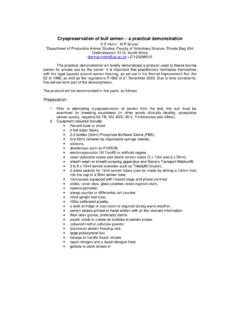Transcription of CONICAL FLUKES IN RUMINANTS - CPD Solutions
1 CONICAL FLUKES IN RUMINANTSDr. Vorster, BVSc, MMedVet(Path)Vetdiagnostix Veterinary Pathology Services, PO Box 13624 Cascades, 3202 Tel no: 033 342 5104 Cell no: 082 820 5030E-mail: Mapham, BVSc (Hon)Veterinary House Hospital,339 Prince Alfred Road, Pietermaritzburg, 3201 Tel no: 033 342 4698 Cell No: 082 771 3227E-mail: fluke is a trematode parasite of the family Paramphistomatidae. This family includes the genera Paramphistomum, Cotylophoron, Ceylonocotyle, Gigantocyle, Gastrothylax Fischoederius, Carmyerius, Gastrodiscus and Pseudodiscus. At least 14 species have been described in domestic RUMINANTS of which the most important FLUKES are Paramphistomum cervi and P. microbothrium. Others are P. microbothrioides, P. liorchis, P. ichikawai and P. explantum. Paramphistomes are found worldwide but disease is most common in the warmer regions in Australasia, Africa, and India and is mostly of clinical significance in cattle, goats and sheep.
2 Calicophoron calicophorum, Ceylonocotyle streptocoelium, Calicophoron ijimai, and Cotylophoron cotylophoron have been associated with clinical disease in buffalo and cattle in Asia, and cattle in Australasia and the southern USA. Various other species of Cotyolophoron, Gastrothylax, and Fischoederius have also been associated with disease in these species. In sheep and goats, , , , , , Cotylophoron cotylophorum, and F. cobboldi have all been associated with clinicaldisease. Species such as Gastrodiscus have been reported in the small and large intestines of equines in tropical regions. Homologaster has been 1associated with the large intestine of RUMINANTS in Asia. Gigantocotyle has been reported from the bile ducts in buffalo in the middle and Far East. Human infestations with certain species of paramphistomes have been reported to have medical importance, but from the public health standpoint, the most important species is Gastrodiscoides hominis.
3 These parasites require an intermediate host in the form of water snails including planorbid snails of the sub family buliniae. The immature parasites are found in the duodenum from where they migrate towards the rumen and reticulum where the adults are situated. The adult parasite is distinctly visible in the forestomachs of RUMINANTS and veterinary practitioners may frequently need to answer questions from clients regarding these observations. In South Africa P. microbothrium seems to be the most important fluke in domestic cycleThe life cycle is fairly typical of the gastrointestinal trematodes. Adult FLUKES reside in the rumen and reticulum and their un-embryonated eggs are passed in the host s faeces. After being freed from the faeces the miracidia hatch from the eggs in water within 12 to 16 days and penetrate the intermediate host. Within the snail sporocysts are formed and then a number of generations of rediae may occur resulting in the production of free swimming cercariae which encyst, as metacercariae, on water plants to be ingested by the ruminant host snails are members of the Gastropoda, Planorbidae, subfamily Bulininae and the genus Bulinus particularly Bulinus tropicus is the most important intermediate host in South Africa.
4 Miracidia parasitise young snails from birth up to the age of three weeks. Sporocysts are found in the snail within a day and they may be present for up to 11 days. Rediae are observed from 14 days after the snail has been parasitised and daughter rediae are seen from day 20 to day 28. Cercaridae start developing from day 30 and may emerge between day 43 and day 48. Development of second, third and fourth generations rediae, follows a similar pattern as the first generation. Some of these infested snails may continue to shed cercariae for a period of a year. These snails themselves reproduce very rapidly. 2 Cercariae encyst on grass at the water surface and, if they are kept moist and cool, they may survive for two months but metacercariae die off if they become desiccated or completely submerged in water. Metacercariae excyst when in contact with ruminal fluid, HCI, trypsin, an alkaline medium and bile salts. Young FLUKES leave the metacercaria in the duodenum (usually within the first 3 meters of the duodenum) and attach to the mucous membrane of the intestine with their posterior sucker.
5 Immature worms migrate back to the rumen from day 15 to 57. Adults will start passing eggs after metacercariae have been dosed in calves at day 56, and in sheep at day 70. The entire life cycle, from egg to egg, takes a minimum of 110 days in sheep and 132 days in infestation of cattle, sheep and goats with FLUKES is very common. These parasites may survive up to years providing a virtually constant source of infestation for successive generations of snails. The intermediate hosts are extremely adaptable and prolific breeders, which ensure a widespread availability of the snails within infested areas. Asexual multiplication of the parasites in infested snails and the survival of snails for several months in suitable environments may result in the shedding of large numbers of cercariae. Clinical outbreaks of paramphistomosis are usually confined to the drier months due to snail populations becoming concentrated around natural sources of water and, as these areas may provide the only dry season grazing, animals may become heavily infested.
6 Reyneke (1983) reports that cattle develop a strong immunity to P. microbothrium which may be dependent on the presence of adult parasites in the rumen. Sheep were reported to be less resistant after attempts to immunise them by artificial cattle, sheep, goats and horses may be the definitive hosts of intestinal or live FLUKES Conradie (2008) reports infestations of Paramphistomum spp in impala, Amphistome in kudu, Calicophoron and Cotylophoron spp in nyala, Calicophoron in blue wildebeest, Paramphistomum spp in gemsbuck and Cotylophoron and Paramphisomum spp in waterbuck in the Limpopo province. It would appear that game species may be occasional, accidental or even definitive hosts of intestinal snails are aquatic and adaptable and therefore occupy far more diverse habitats than lymnaeid snails (intermediate hosts for Fasciola spp). Endemic areas for intestinal paramphistomosis and hepatic fasciolosis therefore do not necessarily snails multiply very rapidly in warm, watery environments and can be found on pastures prone to flooding, on herbage in and around ponds, streams and other water sources.
7 Figure: 1 Bulinus globosus The shell is sinistral with a spire and a size of between x Kock et al (2005) described the geographical distribution, habitats and role of the freshwater snail, Bulinus forskalii as intermediate host, in South Africa. The records studied showed an extensive distribution in KwaZulu-Natal Province, the Limpopo Province, the coastal areas of the Eastern Cape Province and the south-eastern part of the North West Province. The distribution of Bulinus tropicus may speculatively be expected to be bodies were categorized into seasonality (perennial, seasonal), velocity (fast flowing, slow flowing, standing), colour (clear, watery), salinity (fresh, brackish) and substratum types (muddy, stony, sandy, decomposition material). The most favourite circumstances seemed to be perennial habitats ( ), habitats with standing water ( ), habitats with clear water ( %), fresh water habitats ( %) and habitats with a muddy substratum ( %).
8 Most snails ( %) were recovered from habitats with a mean yearly temperature interval ranging from 15 20 C. The authors quoted the recorded recovery of B. forskalii from brooks, channels, concrete dams, dams, ditches, irrigation burrows, pans, ponds, quarries, rivers, springs, swamps and waterholes. The 4highest percentages of snails were recovered from dams ( %) and brooks ( %).B. forskalii has been recognized to play a role in the natural transmission of the CONICAL fluke , Calicophoron microbothrium, of cattle, goats and sheep in Ethiopia and Niger but its role in South Africa for these host species, has not yet been clarified. This snail has been reported as an intermediate host for the natural transmission of Gastrodiscus aegyptiacus in equids, pigs and warthogs in South Africa, and horses, donkeys and mules elsewhere in (1983) describes Bulinus tropicus as the intermediate host of Paramphistomum microbothrium, Calicophoron spp and Gastrodiscus aegyptiacus.
9 In Zimbabawe Mavenyengwa et al (2006) reports Bulinus tropicus, as the intermediate host of Calicophoron microbothrium, to have a wide distribution and incriminated it in the majority of outbreaks of paramphistomosis in RUMINANTS in Zimbabwe and the rest of Southern Africa. Phiri et al (2007), in their studies in Zambia, reported FLUKES to be present throughout the year with the highest abundance rate ( ) found during the post-rainy season (March to May) and the lowest ( ) during the cold dry season (June to August). The highest mean egg counts and number of cattle found positive were recorded in the rainy (December to February) and post-rainy seasons (March to May). They found no significant differences in abundance rates between sexes or between ages of cattle. Tarig et al (2008) studied the prevalence of paramphistomosis in the southern Himalayas and reported it to be Generally, season and age were the factors found to have a significant influence on the risk of paramphistomosis in sheep.
10 The highest infestation was found in the summer season; lower age groups, in males and in the migratory (Bhakarwal) breed. Lower prevalences were reported in winter, adult animals, females and local investigations have shown that mild temperatures and frequent rainfall throughout the year are suitable conditions for the infestation of cattle with trematode parasites like liver or CONICAL fluke . There are several reports from overseas claiming that an increased prevalence of Paramphistomum spp infestation is being seen. Mage et al (2002) describes an epidemiological survey in Central France which demonstrated that the prevalence of natural infestations with Paramphistomum sp in cattle increased from in 1990 to in 1999. This has been partly attributed to the efficacy of fasciolosis control that leaves more intermediate host (Galba 5truncatula) available for the development of paramphistomes. Other reasons proposed were better quality of diagnosis for the detection of fluke eggs and a lack of an effective treatment against cattle paramphistomosis.







